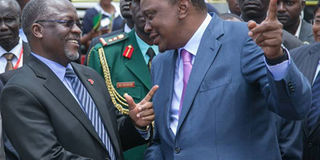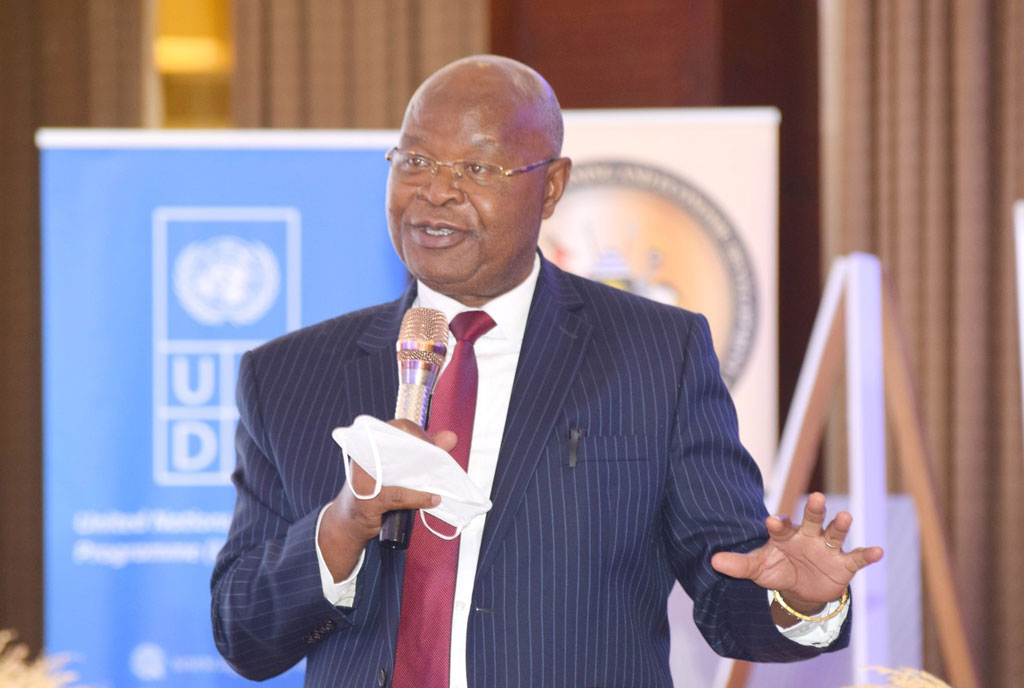Kenya-Tanzania row over oil pipeline deal

GOOD OLD DAYS: Tanzania's John Pombe Magufuli and Kenya's Uhuru Kenyatta share a light moment recently.
Kampala.
With one of them set to lose out on the proposed multi-billion dollar crude oil export pipeline deal from Uganda, a rift has developed between neighbouring Kenya and Tanzania.
Tanzanian authorities on Wednesday, it emerged, confiscated the passports of Kenyan energy secretary (minister), Charles Keter, Petroleum principal secretary, Andrew Kamau and energy principal secretary Joseph Njoroge and Lapsset CEO Sylvester Kasuku, and denied them access to the port of Tanga.
The Kenyan officials were in company of the Ugandan team led by Energy Minister Irene Muloni and other technical personnel, who were tasked early this week at a meeting between President Museveni and his counterpart Uhuru Kenyatta to analyse the cost-benefit of the proposed routes for the multi-billion dollar pipeline infrastructure.
According to Daily Nation, our sister newspaper, the Tanzanian “officials took away the travel documents” reportedly in reciprocation of Kenya’s failure to invite a team from Tanzania to Lamu port, when the Ugandan team had toured or to the Monday’s Nairobi State House talks.
“They [have] also refused us entry into the port of Tanga,” Mr Njoroge told Daily Nation.
The Kenyan and Ugandan officials started with the inspection of the port at Lamu, an archipelago in the Indian Ocean. This is the first proposed route destination of the pipeline from the Albertine Graben/Hoima via Kenya’s Lokichar oil belt at Lokichar, to the coast.
The route to Lamu is approximately 1,300 km (808 mile) with a tagged cost of $4.5b (approx. Shs14.9t). The port is part of Kenya’s ambitious Lamu Port Southern Sudan-Ethiopia Transport (LAPSSET) Corridor project, poised to be the country’s second transport corridor after the Mombasa port corridor.
The second proposed route is from Hoima snaking down south to Tanzania via Masaka to Bukoba to the Tanga port at the Indian Ocean. The route measures approximately 1,403kilometer (876-miles) pegged on a cost of $4b (Shs13t), according to earlier studies.
Uganda has since last year been oscillating between her two neighbours with the pipeline deal, one of the key infrastructures required besides a mid-size [30,000 barrels per day] refinery, as the three international oil companies, UK’s Tullow, France’s Total and China’s Cnooc, make preparations to leap to the next phase of field development/production. The pipeline will facilitate exportation of oil to the international market.
Uganda has a long-standing trade relationship with Kenya to the East while Tanzania is a long-standing political/historical ally to the South. Over 90 per cent of Ugandan cargo, according to ministry of Trade data, goes through the Mombasa port and about 2 per cent goes through the Dar es Salaam port.
Ms Muloni could not be reached immediately by her phone number for an update about the ongoing negotiations. The technical team declined to comment on the pipeline discussions and referred the issue to the minister.
However, an official close to the discussions, intimated to this newspaper that following Monday’s presidential meeting, the Kenyan side has offered some incentives like dropping all the proposed tariff rates for the oil flow and has also indicated “maximum” security will be guaranteed for the infrastructure.
Kenya had initially protested some preconditions, which left a deal with them hanging, and prompted Uganda to start talks with Tanzania. If guaranteeing security at Lamu was not convincing enough, the official said, Kenya had also put cards on the table for Mombasa port.
By press time yesterday, engagements were ongoing with the Tanzanian side.
At Monday’s meeting where Tanzania was not invited between Presidents Museveni and Kenyatta, technical teams from both sides were directed to harmonise presentations.
The benchmarks for the viability of the export route will be determined by least-cost option for a regional integrated pipeline, addressing constructability issues along all routes—existing and planned infrastructure, terrain, and elevations, assessing and confirming proven [oil] reserves.
The two presidents are set to reconvene in two weeks’ time over the matter.
THE BACKGROUND
Uganda’s current stock tank oil in place stands at 6.5 billion barrels [1.4b recoverable] while in Kenya, Tullow Oil recently completed exploration and appraisal phases in South Lokichar, and only 600 million barrels of oil have been discovered so far. Tanzania’s gas reserves on the other hand are estimated at around 55 trillion cubic feet; which all require the pipeline.



